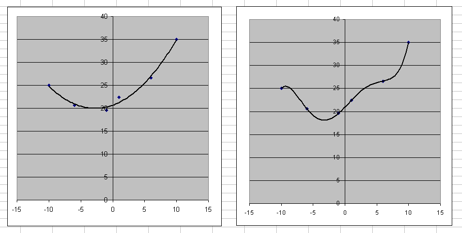PolynomialProjection.PolynomialDegree Property
Gets the degree of the polynomial (1, 2 or 3).
Syntax
public System.Int32 PolynomialDegree { get; }Property Value
Default: 2
The degree of the polynomial.
Remarks
Valid values are 1, 2 and 3. To use a higher degree, you need more ground control points.
Degree | Minimum number of ground control points |
|---|---|
1 | 3 |
2 | 6 |
3 | 10 |
A higher degree means that the polynomial projection can adapt closer to the given control points. Unfortunately, this does not necessarily means a better approximation between the control points. The image below illustrates this problem (for a one-dimensional polynomial) by showing a 2nd degree polynomial adapted to a set of points to the left, and a higher-degree polynomial adapted to the same set of points to the right. The higher-degree polynomial matches the control points very well but at the cost of wobbling between the control points.
 |
As a rule of thumb, try degree 1 first and use it if satisfactory. If not, try degree 2 and finally degree 3. Polynomials of lower degree are faster to evaluate and have better numerical stability.
Platforms
Windows, Linux, Android